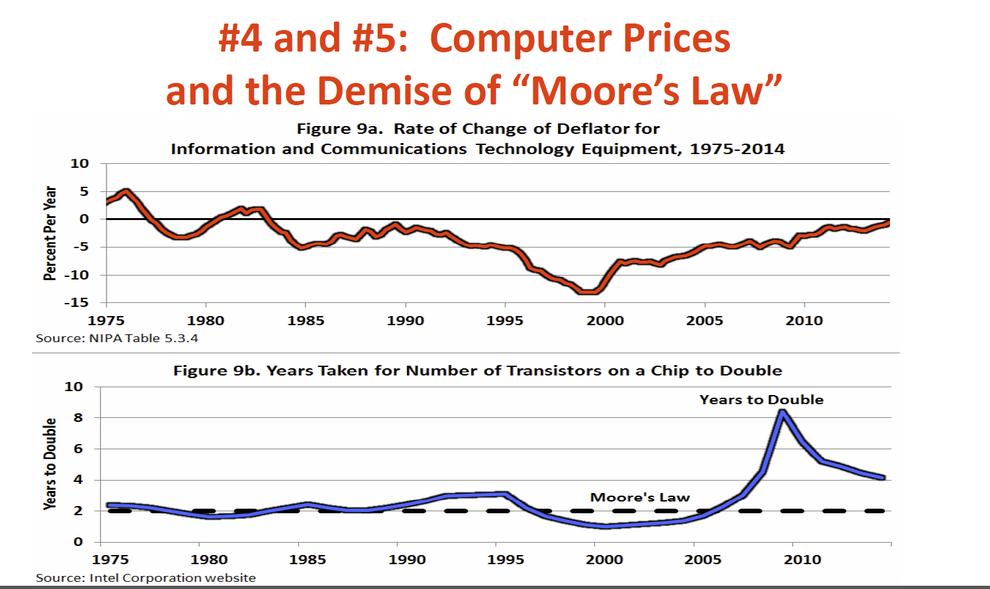There's more to Moore’s Law than transistor counts
- 04 April, 2017 14:40

Picture: Krbo (Flickr)
The PC industry has faithfully followed Moore’s Law since Gordon Moore first announced in 1965 that the density of transistors on a chip will double every year. What many people don’t know is that Moore’s law was actually revised in 1975 to state that the density doubles every two years instead. Things have been a bit shaky of late and this law is stagnating. The announcement of Intel’s 8th Gen CPU, which is still being powered by a 14nm processor, effectively means that we’ve had the same chip density on the market for some five years. So is Moore’s law dead? Many say it is. I disagree.
Moore’s Law, from a purist’s point of view, has always been about computing power. But it isn’t just about cramming more transistors into a space. Instead, it’s about making computing power affordable for the masses. Take a step back and think about the first man on the moon and colour TVs, then the progression to the personal computer — what is the true meaning of Moore’s law?
According to Moore:
- Die sizes were increasing at an exponential rate and as defective densities decreased, chip manufacturers could work with larger areas without losing reduction yields - (cost)
- Simultaneous evolution to finer minimum dimensions - (functional use, practicality, access)
- "Circuit and device cleverness" as Moore called it - (systems/devices as a whole that serve a purpose)
I interpret these critical points as cost reduction, practical usage, and sub-components working as part of an overall system that is affordable, accessible, usable and purposeful.
Depending on who you ask within the industry, the interpretation of Moore’s Law differs. In Moore’s reasoning, it is a “log-linear relationship between device complexity (higher circuit density at reduced cost) and time.” Simply put, it is more-meaningful computing power at affordable prices. This triggers a secondary off-shoot (or complementary law) of Moore’s Law, which is Rock’s Law, but we can save that one for another time.
So does that mean that Moore’s Law is akin to a moving goal post? It isn’t about more transistors crammed into a set area; it’s a changing set of guidelines for people to make more meaningful systems. After all, what good is a processor on its own anyway?
To better understand this point, let’s look quickly to PC history for some clues.
A quick historical recap (Source: Professor Wouter Den Haan, Chair LSE)
Changed Business Practices, Pre-Internet Phase 1, 1970-1995
•1970 mechanical calculators, repetitive retyping, file cards, filing cabinets
•1970s. Memory typewriters, electronic calculators
•1980s. PCs with word processing and spreadsheets
•Late 1980s. E-mail, electronic catalogues, T-1 lines, proprietary software
Completing the Change, 1995-2005
•Late 1990s. The web, search engines, e-commerce
•2000-05 flat screens, airport check-in kiosks
•By 2005 the revolution in business practices was almost over

Concluding recent PC history
From 2005 until now, offices use proprietary information, desktop computers and laptops in pretty much the same way they did post-1994. The current major tech companies and trends that we consider as recent champions of tech growth are Amazon (1994), Google (1998), Wikipedia (2001), iTunes (2001), BlackBerry (2003), Facebook (2004), the iPhone (2007) and the iPad (2010). The effect of the smartphone boom in 2007 and the tablet boom of 2010 I think needs to be discussed separately and I will leave that for another date. It is important to note however, that both inventions have not transformed the way business is done at its core unlike, say, email, the Internet and the PC, which have.
The smartphone and tablet are improvements on a category that have already done most of its disruptiveness in the office. The advent of smart watches and Fitbit-like devices can now be seen mostly as a fad that failed to go mainstream and it is something that I personally was challenged with launching into a few years ago. I would say our team did a great job in bypassing this category at the time (IOT and smart devices still have a place, just not for us right now). We also argued that tablets would go the way of Netbooks (remember them?) and it looks like they are not a category that will be able to stand by themselves. We have an onslaught of 2-in-1 devices coming and they seem to be a rather logical evolution of the notebook PC, taking the good elements from tablets and becoming a meaningful device for some users, but for now, let’s go back to Moore’s law.
To put it really simply, Moore’s Law means something different to everyone. For me as a computer designer, it means making powerful computers that are affordable and useful. Hence, from that perspective, I think Moore’s Law is far from dead. Thus, as a team, we are going to carry on making more powerful computers that can do more, not just because they have double the density of transistors, but because this implied increase in power is meant to transform into more-meaningful computing. At the end of the day, wouldn’t having better battery life, a faster hard drive, better screen and Wi-Fi be meaningless unless it amounted to better performance and a more positive value-added computing experience? If we could also keep it affordable, then Moore’s Law is well and truly alive and it continues to benefit us all.
A sustainability angle should probably also be added to it i.e. we need to think of the full product life-cycle of a device and its flow-on effects of its own ecosystem (e.g. cable, etc). After all, Moore’s law has changed before and it can be adjusted again.
Jaan Turon is Chief Designer and Director of Venom Computers | Twitter | Instagram: jaanturon




